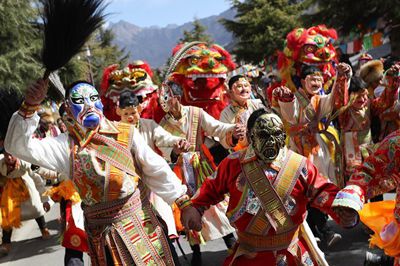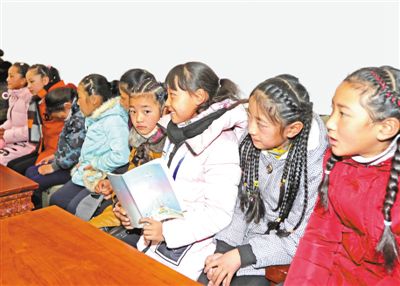In the 7th century, some pilgrims set up tents around the Jokhang Monastery after its completion. Later on, more businessmen came here and built up houses. With the passage of the time, it evolved into the famous Barkhor Street. The third path was called "Linkhor", which surrounded the whole of Lhasa City. In the early morning, an endless stream of worshippers, mostly old ones, could be seen turning prayer wheels. Looking around from the Jokhang Monastery, you could see reticulate pilgrim paths stretching out to cover the whole plateau. Buddhism had a terminology of "enchantment", which means that common buildings or statues were endowed with the meaning of Buddha through a sutra chanting ceremony presided over by eminent monks. The statue of twelve-year-old Sakyamuni in the Jokhang Monastery was made when Sakyamuni was alive and was enchanted by himself. Therefore, worshipping his stature was like paying respect to the real Sakyamuni. The practice of drawing lots from a gold urn by eminent monks to determine the reincarnated soul boy of the 10th Panchen Lama in front of the stature of Sakyamuni implies that the lots-drawing result was decided by Sakyamuni. The procedure also had the meaning of enchantment since it turned a gifted yet ordinary person into a god on the earth. It reminded me of the 17th Karmapa Living Buddha Ogyen Trinley confirmed by the central government two years before, and previous Dalai Lamas and Panchen Lamas, most of whom were ordained and taught Sramanera Precepts and Monastic Discipline in front of the Sakyamuni statue. Then, it was not difficult to understand the importance of the decision made by Sakyamuni. III. The lots-drawing ceremony began at 5 a.m. Around 4 a.m., 1,000 representatives from all walks of life began to enter the hall, sitting on the pier on which monks of the Jokhang Monastery used to chant sutra. These representatives wearing festival costumes included farmers, local residents, workers, and monks from the Tibetan-inhabited areas in Sichuan, Qinghai, Gansu, and Yunnan provinces. Only ten special journalists with red passes were allowed to stay around the wooden platform in the principal nave. Other reporters originally planned to stay on the second floor where they could observe the lots-drawing ceremony clearly. But lamas were unwilling to do so for fear that they might tumble over the glee lamps placed on the guard bars. Since no one dared to take the risk, those reporters finally went downstairs to the principal nave, reluctantly standing in a line against the wall. Chen Hanchang, a member of the Standing Committee of Tibet Autonomous Regional Committee of the CPC and director of the Publicity Department of Tibet Autonomous Regional Committee of the CPC, talked with Deputy Director of Radio a |
- Home
- News |Tibet |Exclusive |China |World |Other Tibetan-Inhabited Area |Tibet through the Eyes of Foreigners |Related News
- Documents |White Papers |Others
- Photo |Politics |Economy & Society |Culture & Religion |Human & Nature |Beautiful Tibet |Other Tibetan-Inhabited Area |Exchanges |Related
- Video |News |Documentary |Micro-Video |Entertainment
- Art
- Tourism
- In Focus
- About Tibet






